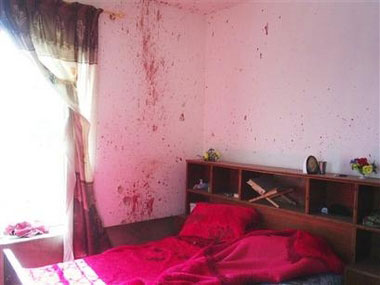In Haditha, the Marines, enraged by the loss of a comrade, stormed into
nearby homes in the area and allegedly shot occupants dead as well as several
men in a taxi that arrived at the scene of the blast, according to U.S.
lawmakers briefed by military officials.
In one of the homes, Marines ordered four brothers inside a closet and shot
them dead, said the Haditha lawyer, Khaled Salem Rsayef.

This image is believed
to have been taken a day or two after the Haditha incident, and was made
available in Baghdad, Iraq,Friday, June 2, 2006. by lawyer Khaled Salem
Rsayef, but was not taken by him. It purportedly shows the scene in one of
the houses in Haditha, Iraq after two dozen civilian Iraqis were allegedly
killed by U.S. Marines last November, which Rsayef said Friday was carried
out by three or four Marines while about 20 more waited outside.
[AP] |
Rsayef said he himself lost several relatives in the alleged massacre,
including a sister and her husband, an aunt, an uncle and several cousins. He
and his brother, Salam Salem Rsayef, spoke to The Associated Press by telephone
from the Euphrates River town of 90,000 late Thursday and Friday.
Despite the Iraqi government's insistence of cooperation between the U.S. and
Iraqi investigations, the Rsayefs said they and other victims' families refused
the request several months ago to exhume the bodies.
"No way we can ever agree to that," Salam Salem Rsayef said. Under Islamic
teachings, exhuming bodies is prohibited, but is allowed on case-by-case basis,
sometime after a fatwa, or an edict, from a senior cleric allowing it to
proceed.
The Rsayef brothers met at least four times with U.S. military investigators
looking into the killings. They said the meetings began in February and were
held at Samarra General Hospital. The next meeting is scheduled for Sunday, the
two brothers said, suggesting that the U.S. investigations are not finished.
Khaled Salam Rsayef identified the four brothers killed in the closet as a
car dealer, a traffic policeman, an engineer and a local government employee. He
said the U.S. military did not give compensation payments to their families
because the brothers were believed to be insurgents.
The lawyer said his account of what happened was based on his personal
observations from the rooftop of his home and windows. He said his house is
several dozen yards away from the three homes raided by Marines. The killings,
which he did not witness in person, were recounted to him and other members of
his family the following day by survivors, he said.
He said his own home shook violently when the roadside bomb went off at 7:15
a.m. and that intermittent gunfire lasted for about two hours. He could not go
out of his house to see for himself, but managed to steal quick glances from his
roof and from behind windows.
"About 5 p.m. I emerged with my family carrying white flags," he said. "We
wanted to move away from the area fearing that shooting could resume."
The New York Times, in a story for Saturday editions posted on its Web site,
quoted a senior Marine officer as saying that commanders learned within two days
that civilians in Haditha were killed by gunfire and not a roadside bomb. But
the officer, who wasn't further identified, said officials had no information
suggesting the civilians had been killed deliberately and saw no reason to
investigate further.
The Haditha attack came four months before the nighttime raid in the village
of Ishaqi, about 50 miles north of Baghdad.
A U.S. ground force conducted the Ishaqi attack, said two defense officials
in Washington. After being fired upon from the targeted building, the soldiers
pulled back and called in airstrikes by an Air Force AC-130 gunship, which
attacked and collapsed the building, they said.
One of the officials said the investigation into the circumstances of the
Ishaqi attack found that four people in the building were killed by U.S. forces,
including two women and a child. The main target of the attack, said by U.S.
intelligence to be an al-Qaida figure, ran from the building but was later
captured, the official said.
Caldwell said that a search found "the body of Abu Ahmed plus three
noncombatants," while the "investigating officer concluded that possibly up to
nine collateral deaths resulted from this engagement but could not determine the
precise number due to collapsed walls and heavy debris."
Local Iraqis said there were 11 dead, contending they were killed by U.S.
troops before the house was leveled.
The bloody aftermath of the attack was captured at the time in the footage
shot by an AP Television News cameraman. The video became the focus of attention
Friday when the BBC aired it in the wake of recent allegations of U.S. troops
killing unarmed civilians.
The footage shows at least one adult male and four of the children with deep
wounds to the head that could have been caused by bullets or shrapnel. One child
has an obvious entry wound to the side and the inside of the walls left standing
were pocked with bullet holes. A voice on the tape said there were clear bullet
wounds in two people.
The video includes an unidentified man saying "children were stuck in the
room, alone and surrounded."
"After they handcuffed them, they shot them dead. Later, they struck the
house with their planes. They wanted to hide the evidence. Even a 6-month-old
infant was killed. Even the cows were killed, too," he said.
Although it has been known that U.S. air power was involved in the assault on
the building in Ishaqi, it was not previously reported that there was an AC-130
gunship, a devastating weapon capable of operating at night and pummeling its
target with side-firing guns, including a 105mm cannon. The gunship is flown by
Air Force Special Operations crews.